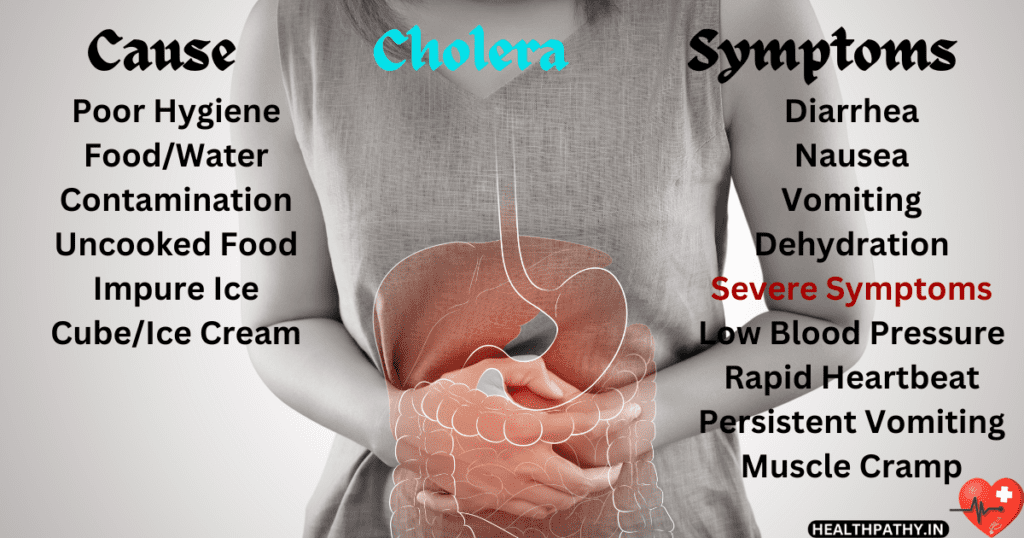Cholera is an excessive and potentially lethal diarrheal ailment that has plagued humanity for centuries. This article Cholera Cures With Scientifically Proven Homeopathy delves into the definition, causes, types, signs, and symptoms, as well as numerous remedy alternatives for cholera, such as homeopathic remedies. Additionally, we’ll explore nutritional recommendations and easy domestic treatments and provide vital dos and don’ts to assist in manipulating and saving you from cholera.
- Cholera Cures With Scientifically Proven Homeopathy
- What Is Cholera?
- Culprits Of Cholera
- Types Of Cholera
- Signs and Symptoms:
- Effective Homeopathic Cure
- Trusted Mother Tinctures Cure
- Other Safe Treatment Options
- Diet Tips For Prevention And Maintenance
- The Power Of Do's:
- Mastering The Don'ts:
- Conclusion:
- FAQ
- Must Read:
- Must Watch:


What Is Cholera?
Cholera is an especially contagious bacterial contamination caused by the Vibrio cholerae bacterium. It spreads via contaminated water and meals. It mainly affects the small intestine, leading to intense diarrhea and dehydration. Cholera can be life-threatening if not handled promptly.
Culprits Of Cholera
Cholera is generally transmitted through contaminated water and meals. Mainly in areas with inadequate sanitation and terrible hygiene practices, it contributes to its spread. When a person can shed bacteria from their feces, that could then contaminate water assets, leading to outbreaks. Vibrio cholera prospers in unclean water resources and can infect people who ingest it.
Types Of Cholera
There are two primary sorts of cholera:
1. Epidemic Cholera: Occurs at some point during outbreaks and can unfold hastily in densely populated regions.
2. Endemic Cholera: Persists in certain regions over time and is much less excessive than epidemic cholera.
It again subdivided into two, based on strain:
2.1. O1 Cholera: This is the most common and extreme type accountable for most cholera outbreaks.
It seems like you’re referring to a selected cholera strain called “O1 Cholera.” Vibrio cholerae O1 is the most unusual and clinically significant stress of the cholera bacterium. It is responsible for most of the cases of cholera globally.
Vibrio cholerae O1 is divided into two fundamental serogroups: Inaba and Ogawa, primarily based on the particular antigenic properties of the bacterium. These serogroups can further be labeled into two biotypes: classical and El Tor.
2.1.1. Inaba: This serogroup of Vibrio cholerae O1 is characterized by the presence of the Inaba antigen. It is associated with certain cholera outbreaks.
2.1.2. Ogawa: The Ogawa serogroup consists of the Ogawa antigen and is every other subtype of Vibrio cholerae O1. It’s also associated with cholera outbreaks.
Both the Inaba and Ogawa strains can cause cholera, and they have similar clinical signs and symptoms. The desire for strain identity is regularly essential for epidemiological functions and might help trace the source and unfolding of cholera outbreaks.
It’s crucial to be aware that irrespective of the unique strain, cholera is a diarrheal disorder because of Vibrio cholerae, and the remedy and preventive measures remain in large part the same, specializing in rehydration and sanitation to control and prevent the sickness.
2.2. O139 Cholera: This kind is much less unusual and typically much less extreme, but can nevertheless cause outbreaks.
Vibrio cholerae O139, frequently called “O139 Cholera,” is another strain of the cholera bacterium that can cause cholera in people. This strain is wonderful compared to the more unusual Vibrio cholerae O1, which is responsible for most cholera cases worldwide.
Here are a few key factors affecting Vibrio cholerae O139:
2.2.1. Vibrio cholerae O139 was first diagnosed in 1992 in the coastal regions of Bangladesh and India. Before its emergence, most cholera cases were attributed to the O1 serogroup.
2.2.2. Antigenic Properties: O139 Cholera gets its name from the particular antigenic properties of the bacterium. It carries the O139 antigen, which distinguishes it from other cholera lines.
2.2.3. Similar Clinical Symptoms: The scientific signs of cholera because of Vibrio cholera O139 are similar to the ones resulting from the O1 strain. These signs commonly encompass profuse watery diarrhea, vomiting, dehydration, and electrolyte imbalances.
2.2.4. Treatment: The treatment for cholera as a result of O139 is similar to that for other cholera traces and focuses on rehydration. Oral rehydration answer (ORS) and, in extreme instances, intravenous fluids are essential to replace misplaced fluids and electrolytes.
2.2.5. Prevention: Preventive measures for O139 cholera encompass getting admission to clean and safe ingesting water, proper sanitation and hygiene practices, and vaccination if available and advocated in affected areas.
2.2.6. Epidemiology: O139 Cholera has been responsible for outbreaks in various parts of the world, especially in Asia. It is important to screen and tune the unfolding of this strain for public health purposes.
While Vibrio cholerae O139 represents a specific strain of cholera bacterium, the overall concepts of cholera prevention and management continue to be consistent with the ones for other cholera traces. Timely rehydration and sanitation measures are vital in controlling cholera outbreaks, regardless of the specific stress involved.
Signs and Symptoms:
Cholera symptoms can range in severity, but they commonly include:
Sudden onset of profuse, watery diarrhea
Vomiting
Dehydration
Muscle cramps
Rapid heart rate
Low blood stress
Sunken eyes
Dry mouth and throat
Effective Homeopathic Cure
| Remedy | Indications |
| Arsenicum Album: | Cholera with excessive restlessness, tension, fear of dying, and burning thirst. Diarrhea is watery and burning. diarrhea worsened with the aid of eating cold water or food. Cold drinks and cold applications worsen the situation. Amelioration: Warmth and warm drinks offer remedies. |
| Veratrum Album: | Profuse, violent vomiting, and diarrhea with cold sweats and excessive weakness, aggravated through cold drinks and damp cold weather, were relieved with the aid of warm temperatures. |
| Cuprum Metallicum: | Cholera with intense cramps, particularly inside the abdomen and limbs, Aggravation: at night. Cold air and cold liquids cause worse symptoms. Amelioration: Warmth and a gentle rubdown provide alleviation. |
| Podophyllum Peltatum: | Profuse, painless, gushing diarrhea, frequently with a sour odor. Morning aggravation and warmness worsen the circumstance. Amelioration: Rest and lying on the abdomen improve signs. |
| Camphora: | Cholera with coldness, cold sweat, cramps, a feeble pulse and excessive prostration. Cold, damp situations worsen the nation. Amelioration: External warmth and masking help. |
Trusted Mother Tinctures Cure
| Remedy | Indications |
| Rhus Aromatica (Rhus Aro) MT: | Cholera with abdominal cramps and diarrhea Cold applications worsen signs. Amelioration: Warmth and gentle motion assist. |
| Phosphorus MT: | It is helpful for cholera with a burning thirst for cold beverages, observed by means of exhaustion and debility. |
| Cinchona Officinalis (China) MT: | Dehydration, exhaustion, debility, and weakness due to cholera are considered. Cholera with excessive thirst and flatulence Touches and drafts of air worsen the situation. Amelioration: Warmth and relaxation provide alleviation, which is relieved by mild rubbing. |
| Ipecacuanha (Ipecac) MT: | Persistent nausea and vomiting in cholera instances, a sense of suffocation, motion, and warm food get worse symptoms. Amelioration: Rest and funky, clean air assist. |
| Veratrum Album MT: | Cholera with intense vomiting and diarrhea accompanied by cold sweat, Cold drinks, and cold weather worsens symptoms. Amelioration: Rest and external heat improve the situation. |
Other Safe Treatment Options
Ginger Tea: Ginger has anti-nausea properties and can assist in alleviating stomach soreness.
Coconut Water: Coconut water is rich in electrolytes and might be a useful resource in rehydration.
Turmeric Paste: A paste crafted from turmeric and water can help lessen diarrhea and infection.
Oral Rehydration Solution (ORS): Prepare a homemade ORS with easy water, sugar, and salt to replace lost fluids.
Diet Tips For Prevention And Maintenance
During a cholera infection, it’s important to be cognizant of rehydration and, without difficulty, digestible meals. The BRAT food plan (bananas, rice, applesauce, and toast) may be an appropriate choice. Consume plenty of clear fluids, together with oral rehydration solution (ORS), to update misplaced fluids and electrolytes.
Diet plays an essential role in convalescing from cholera and preventing further complications. During a cholera episode, the point of interest needs to be rehydration and fending off ingredients that could exacerbate signs and symptoms. Here are some nutritional suggestions for cholera recuperation:
Oral Rehydration Solution (ORS): ORS is the cornerstone of cholera treatment. Consume ORS frequently to replace lost fluids and electrolytes. You can buy ORS sachets at a pharmacy or make a self-made answer with the use of clean water, sugar, and salt in the right proportions.
Clear Fluids: Drink masses of clear fluids together with water, coconut water, and herbal teas (e.g., chamomile or ginger tea) to stay hydrated.
The BRAT Bland food plan (bananas, rice boiled, applesauce, and toast) may be an appropriate choice:
Once vomiting and diarrhea have subsided, regularly introduce bland, digestible ingredients like Plain boiled potatoes and Plain yogurt with stay cultures (probiotics)
Continue Breastfeeding (for infants): If an infant has cholera, preserve breastfeeding. Breast milk is a fantastic source of nutrients and hydration.
Avoid Solid Foods Initially: During the acute phase of cholera, it is best to keep away from solid meals until vomiting and diarrhea have appreciably advanced. This facilitates further inflammation of the digestive tract.
Avoid Dairy Products: Steer clear of dairy merchandise like milk, cheese, and butter, as they can be hard to digest and may get worse signs.
No Spicy or Greasy Foods: Avoid highly spiced and greasy meals as they are able to worsen the belly and digestive systems.
Gradual Food Reintroduction: Once signs and symptoms have subsided, reintroduce solid meals slowly and in small portions. Start with bland foods and gradually develop a regular eating regimen.
Continue Hydration: Even after signs improve, continue to focus on staying hydrated by drinking fluids and ORS until you are completely recovered.
Seek Medical Advice: If symptoms are excessive or persist for a variety of days, seek advice from a healthcare provider for guidance on how to resume an ordinary weight-reduction plan.
Remember that the primary aim at some stage in cholera restoration is to save you from dehydration and electrolyte imbalances. Following these dietary tips, along with well-timed hospital treatment, can result in a quicker and smoother restoration from cholera.
From Do’s to Don’ts: Transforming Your Life for the Better
The Power Of Do’s:
Seek Medical Help: In severe instances, cholera requires immediate medical attention.
Rehydrate: Drink lots of fluids, which include ORS, to save you from dehydration.
Maintain Good Hygiene: Wash arms regularly with soap and clean water. Consume clean and secure ingesting water.
Rest: Rest and preserve strength for health restoration.
Follow nutritional guidelines for cholera restoration.
Mastering The Don’ts:
Not Delay Treatment: Cholera can be life-threatening, so are trying to find set off hospital treatment. Consisting of dehydration or intense cramps.
Don’t Self-Medicate: Consult a qualified homeopathic practitioner for personalized remedies.
Avoid eating raw or uncooked seafood and infected water or meal resources.
Avoid eating stable meals until symptoms improve.
Refrain from eating alcohol or smoking.
Conclusion:
Cholera is a critical diarrheal disease that requires immediate attention and treatment. While homeopathic remedies may be supportive, it is essential to consult a healthcare company for the correct assessment and guidance. Combining hospital therapy with dietary precautions, desirable hygiene practices, and early intervention can assist in saving you and controlling cholera efficiently.
This article presents a complete overview of cholera, its control, and preventive measures, emphasizing the importance of timely and appropriate hospital treatment.
FAQ
Must Read:
Diarrhea Cures With Scientifically Proven Homeopathy
Constipation Cures With Scientifically Proven Homeopathy
Must Watch:
Homeopathy VS Allopathy_A Balance Comparison
Friday 04 April 2025 5:33:41:PM
- Acromegaly Cures With Scientifically Proven Homeopathy - 8 February 2024
- Acidity Cures With Scientifically Proven Homeopathy - 1 February 2024
- Appendicitis Cures With Scientifically Proven Homeopathy - 27 January 2024






